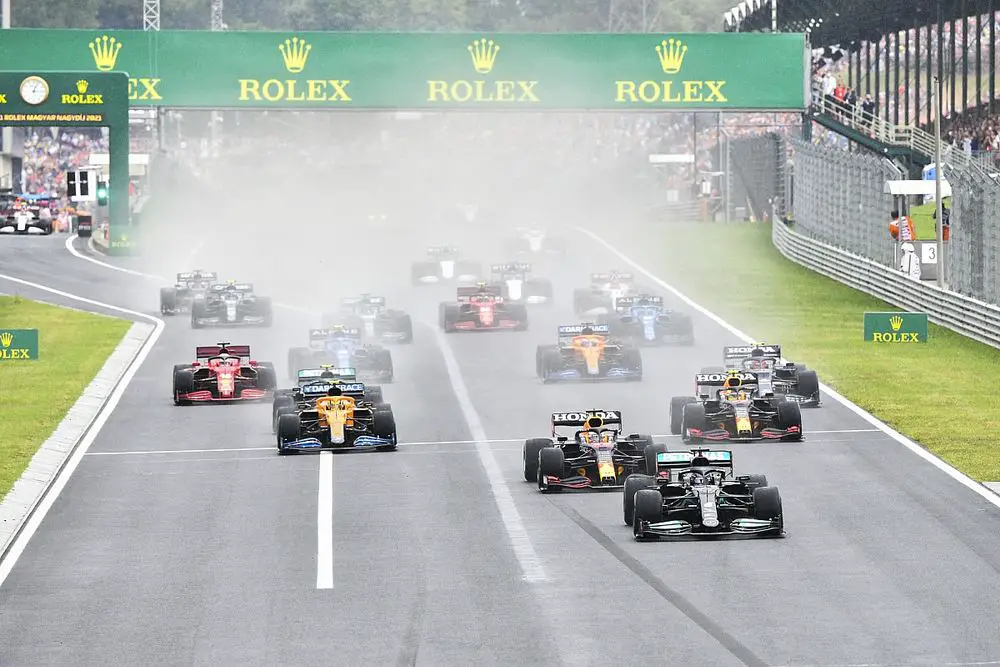The Hungarian Grand Prix is one of the most anticipated and exciting races of the Formula 1 season.
It is held at the Hungaroring, a twisty and challenging circuit that tests the skills and strategies of the drivers and teams. The race is often unpredictable and full of drama, as overtaking is difficult and weather conditions can change rapidly.
In this article, we will tell you everything you need to know about the Hungarian Grand Prix, including its history, highlights, current standings, and how to watch it live from anywhere in the world.
Whether you are a die-hard F1 fan or a casual viewer, you won’t want to miss this spectacular race that could have a huge impact on the championship battle.
The Index To The Article
- When Is The Hungarian Grand Prix?
- The History Of The Hungarian Grand Prix
- The Hungarian Grand Prix Circuit: What to Expect
- Where To Watch The 2023 Hungarian Grand Prix
- How to Buy Tickets for the 2023 Hungarian Grand-Prix
- How To Get To Budapest
- How to You Get To The Hungaroring From Budapest?
- How To Watch The Hungarian Grand Prix
When Is The Hungarian Grand Prix?
The Hungarian Grand Prix takes place at the 4.381-kilometre Hungaroring in Budapest
The Hungarian Grand prix takes place on the weekend of the 21st July 2023 to 23rd July 2023
23 July
Race
15:00
22nd July
Qualifying
16:00 – 17:00
22nd July
Practice 3
12:30 – 13:30
21st July
Practice 2
17:00 – 18:00
21st July
Practice 1
13:30 – 14:30
Hungarian Grand Prix Start Time
The main race starts at 15:00 on 23rd July 2023.
The History Of The Hungarian Grand Prix
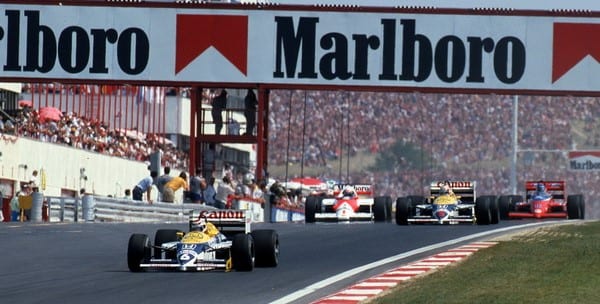
The Hungarian Grand Prix is one of the most historic and unique races on the Formula 1 calendar. It was the first race to be held behind the Iron Curtain, and has been a fixture of the sport since 1986.
From the beginning the race has been held at the Hungaroring, a twisty and dusty circuit that challenges both drivers and teams with its low grip and high temperatures.
The origins of the Hungarian Grand Prix date back to 1936, when the first race was held on a 5-kilometre track in Népliget, a park in Budapest.
The event attracted a large crowd and featured some of the most famous names in motorsport, such as Mercedes-Benz, Auto Union, and Ferrari. However, the race was discontinued after one edition due to political and war-related reasons.
It was not until 50 years later that Formula 1 returned to Hungary, thanks to the efforts of Bernie Ecclestone, who wanted to expand the sport’s reach beyond Western Europe.
After several failed attempts to build a street circuit in Budapest, a new track was constructed in Mogyoród, about 20 kilometers from the capital.
The Hungaroring was designed by John Hugenholtz, who also created Zandvoort and Suzuka, and featured 14 corners and a length of 4.381 kilometers.
The first Hungarian Grand Prix at the Hungaroring was held on August 10th, 1986, and was attended by over 200,000 spectators. The race was won by Nelson Piquet, who overtook Ayrton Senna with a daring move on lap 57. The race also marked the debut of Derek Warwick for Brabham.
It Is Now A Regular Fixture
Since then, the Hungarian Grand Prix has been a regular fixture on the Formula 1 calendar, and has witnessed some memorable moments and milestones. Some of these include:
- Nigel Mansell’s stunning drive from 12th to first in 1989, passing Senna for the lead after the Brazilian was held up by Stefan Johansson.
- Damon Hill’s first win for Williams in 1993, and his near-miss for Arrows in 1997, when he lost power on the final lap and finished second behind Jacques Villeneuve.
- Michael Schumacher’s brilliant strategy change in 1998, when he made an extra pit stop and set a series of fast laps to build a gap over Mika Hakkinen.
- Fernando Alonso’s maiden victory in 2003, becoming the youngest winner in Formula 1 history at the time.
- Jenson Button’s first win in a chaotic wet-dry race in 2006, which also saw Schumacher finish out of the points for the first time since 1999.
- Heikki Kovalainen’s only win in 2008, after Felipe Massa’s engine failure three laps from the end1.
- Lewis Hamilton’s record-breaking eighth win in 2020, surpassing Schumacher’s seven wins at Magny-Cours.
- Esteban Ocon’s shock victory in 2021, after a first-lap crash eliminated several frontrunners and Hamilton dropped to last due to a pit stop error.
The Hungarian Grand Prix is a race that often produces surprises and drama, as well as showcasing the skill and talent of the drivers. It is a race that has a rich history and a loyal fan base, especially among Finns who flock to support their heroes. It is a race that deserves its place among the classics of Formula 1.
The Hungarian Grand Prix Circuit: What to Expect
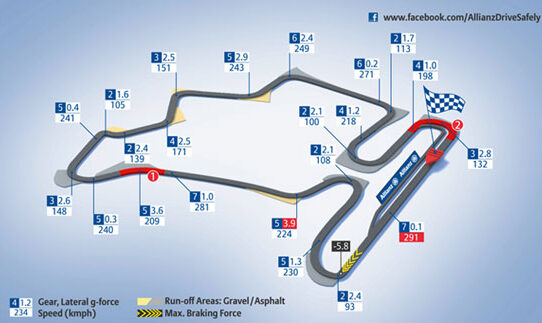
The Hungaroring is a challenging and unique track that tests the drivers and teams with its tight corners, low grip and high temperatures. In this article, we will look at the layout of the Hungaroring and what to expect from the 2023 Hungarian Grand Prix.
The Hungaroring is located in Mogyoród, about 20 kilometers from the capital city of Budapest.
The circuit was designed by John Hugenholtz, who also created Zandvoort and Suzuka, and features 14 corners and a length of 4.381 kilometers.
The Hungaroring Is In A Valley
The track is set in a valley, which allows spectators to see most of the action from certain spots in the grandstands. The track is also surrounded by hills, which create a natural amphitheater effect and amplify the sound of the engines.
The layout of the Hungaroring is often compared to a go-kart track, as it has many slow and medium-speed corners that require good traction and handling. The track is also very narrow and dusty, making overtaking difficult and mistakes costly.
The track has been modified slightly over the years to improve safety and racing quality, but it has retained its original character and charm.
Read our in-depth article describing what it is like to drive an F1 car on the Hungaroring.
Where To Watch The 2023 Hungarian Grand Prix
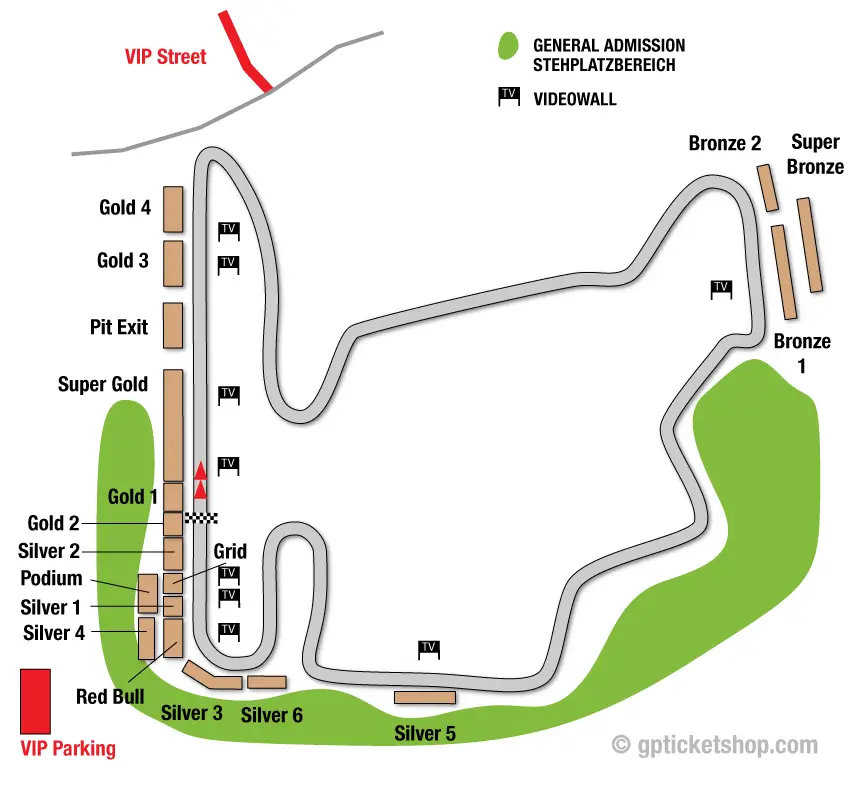
The Hungarian Grand Prix is one of the most historic and unique races on the Formula 1 calendar. The 2023 edition promises to be no different.
But where are the best places to sit at the Hungaroring? What are the best grand stands to watch the Hungarian Grand Prix?
Main Straight: Gold 1&2 And Super Gold
The main straight is where the action starts and ends at the Hungaroring. The grand stands here offer views of the start/finish line, the grid, the podium. Spectators can also see the pit stops and the team garages. The best grand stands on the main straight are Gold 1&2 and Super Gold.
Gold 1&2 are located opposite the top spots on the grid. This means they have a great view of the start of the race, as well as the post-qualifying interviews. They are also opposite the podium, which means they have a great view of the celebrations after the race. Gold 1&2 are also covered, which means they offer some protection from the sun and rain.
Super Gold is located opposite the team garages. This means they have a great view of the pit stops and the team activities. It is also covered, which means it offers some comfort and shade in the hot and dry conditions. Super Gold is also closer to Turn One, which means it has a better view of the first corner action.
Turn One: Gold 3 And 4
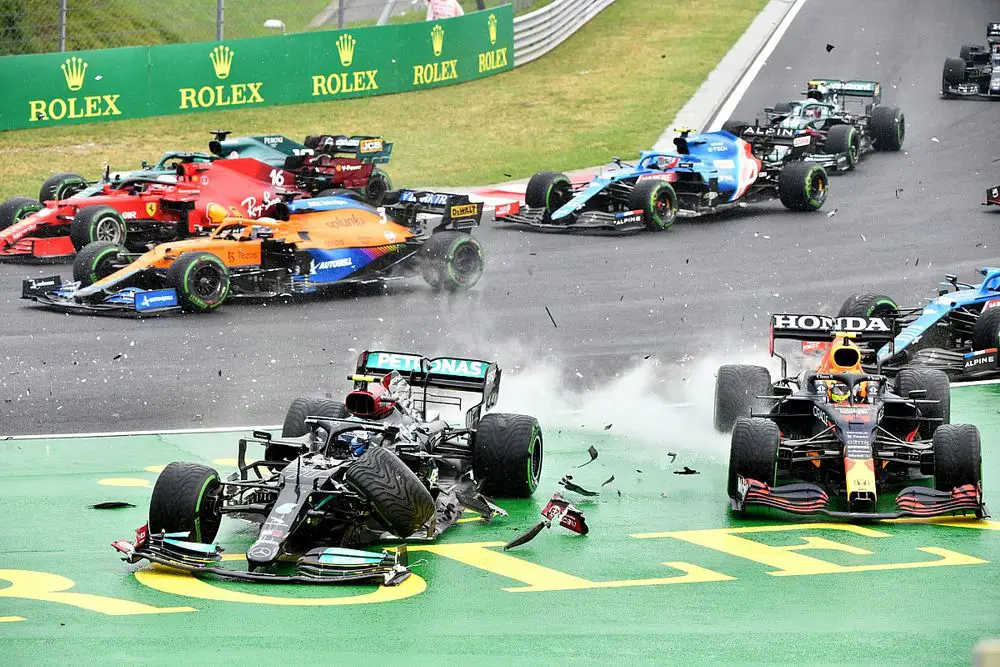
Turn One is one of the best overtaking spots on the track, as it is a right-hand hairpin at the end of a long straight. The grand stands here offer views of the braking zone, the apex and the exit of Turn One. Spectators can also see some parts of Turn Two and Three. The best grand stands at Turn One are Gold 3 and 4.
Gold 3 and 4 are located on either side of Turn One. This means they have a panoramic view of the corner action. They have a cover and protect the occupants from the sun and rain.
Turns Five to Seven: Bronze 1 and 2
Turns Five to Seven are a series of fast and flowing corners that go uphill and downhill. The grand stands here offer views of this section of the track, such as Turn 14 and 15. The best grand stands at Turns Five to Seven are Bronze 1 and 2.
Bronze 1 and 2 are located on the outside of Turns Five to Seven. This means they have a wide view of this section of the track. They are also uncovered, which means they offer a more authentic and immersive experience of the race.
Turn 14: Silver 3 and 6 Grandstands
Turn 14 is one of the most important corners on the track. It is a fast left-hander that leads into the final corner and the pit straight. The grand stands here offer views of Turn 14 and some parts of Turn 13 and 15. The best grand stands at Turn 14 are Silver 3 and 6.
Silver 3 and 6 are located on either side of Turn 14. This means they have a clear view of the corner action. They are also covered, which means they offer some protection from the sun and rain1.
Final Sector: Silver 1,2&4 And Red Bull Grandstands

The final sector of the Hungaroring is a series of slow and tight corners that require good traction and patience. The grand stands here offer views of Turn 13, Turn 15 and the pit entry. The best grand stands in the final sector are Silver 1,2&4 and Red Bull.
Silver 1,2&4 are located on the outside of Turn 13, which means they have a good view of the braking zone and the apex of this corner. They are also covered, which means they offer some protection from the sun and rain.
Red Bull is located on the inside of Turn 15, which means it has a good view of the exit of this corner and the pit entry. It is also uncovered, which means it offers a more authentic and immersive experience of the race.
These are some of the best grand stands to watch the Hungarian Grand Prix from different angles and perspectives. Of course, there are other options available at the Hungaroring, such as general admission areas and VIP packages. Whatever you choose, you will surely enjoy the race at this historic and unique circuit.
How to Buy Tickets for the 2023 Hungarian Grand Prix
How can you buy tickets for the 2023 Hungarian Grand Prix? What are the best options for different budgets and preferences? In this article, we will answer these questions and help you find the best way to enjoy the race.
There are several ways to buy tickets for the 2023 Hungarian Grand Prix, depending on your location, availability and convenience. Some of the most common ways are:
Online
You can buy tickets online from various official retailers, such as
- The Main Formula1.com website
- Motorsport Tickets
- F1 Destinations
- Grand Prix Events.
These websites offer a wide range of tickets, from general admission to grand stands to hospitality packages and VIP experiences. You can also compare prices, availability and views from different seats and areas.
Buying tickets online is convenient and secure, as you can pay with your credit card or PayPal account and receive your tickets via email or courier.
Phone
You can also buy tickets by phone from some of the official retailers, such as Motorsport Tickets and Grand Prix Events.
This option may be useful if you have any questions or special requests regarding your tickets, such as group bookings, wheelchair access or children discounts. You can also pay with your credit card or bank transfer and receive your tickets via email or courier.
On-site
You can also buy tickets on-site at the Hungaroring, either at the ticket office or at the ticket booths around the circuit.
This option may be suitable if you are already in Budapest or nearby and want to buy your tickets last-minute or in person. However, this option may also be risky, as some of the popular tickets may be sold out or more expensive than online.
When buying tickets for the 2023 Hungarian Grand Prix, you should also consider some factors, such as:
The Budget You Have Available To Watch The Hungarian Grand Prix
The price of the tickets varies depending on the type, location and duration of the ticket.
For example, general admission tickets are cheaper than grand stand tickets, but they offer less comfort and views.
Similarly, weekend tickets are more expensive than single-day tickets, but they offer more access and flexibility. You should also consider other costs, such as travel, accommodation and food.
You Personal Preferences To Watch The Hungarian Grand Prix
The choice of the ticket also depends on your personal preference and expectation of the race. For example,
if you want to see the start/finish line, the grid, the podium and the pit stops, you may prefer a ticket on the main straight, such as Gold 1&2 or Super Gold.
If you want to see overtaking action and braking zones, you may prefer a ticket at Turn One, such as Gold 3 or 4.
To see fast and flowing corners and elevation changes, you may prefer a ticket at Turns Five to Seven, such as Bronze 1 or 2.
If you want to see fast and flowing corners and elevation changes, you may prefer a ticket at Turns Five to Seven, such as Silver 3 or 6. If you want to see the final sector and the pit entry, you may prefer a ticket at Turn 15, such as Silver 1,2&4 or Red Bull.
Ticket Availability To Watch The Hungarian Grand Prix
The availability of the tickets varies depending on the demand and the time of booking.
Some of the popular tickets sell out fast or increase in price as the race date approaches. Therefore, it is advisable to book your tickets as early as possible to secure your preferred seats and avoid disappointment.
How To Get To Budapest
The Hungaroring is the circuit that hosts the Hungarian Grand Prix, one of the most historic and unique races on the Formula 1 calendar.
The circuit is located in Mogyoród, about 20 kilometers from the capital city of Budapest. It is set in a valley, which allows spectators to see most of the action from certain spots in the grandstands. The circuit is also surrounded by hills, which create a natural amphitheater effect and amplify the sound of the engines.
But how can you get to the Budapest for the 2023 Hungarian Grand Prix? What are the best options for different modes of transport? In this article, we will answer these questions and help you find the best way to enjoy the race.
There are several ways to get to the Hungaroring, depending on your location, availability and convenience. Some of the most common ways are:
The Hungarian Grand Prix By Air



Most international visitors arrive at Hungary’s primary airport, the Budapest Franz Liszt International Airport (BUD), which is 16km South East of the city center.
The airport serves a range of European and long-haul flights, with many budget airlines such as Easy Jet, Ryanair and WizzAir.
An alternative preferred by some fans is to fly to Vienna or Bratislava and travel to Budapest by bus or train.
The Hungarian Grand Prix By Train
If you have more time and want to see some of the countryside, taking the train to Budapest is a great choice.
The city is well connected to Europe’s extensive rail network and there are day and overnight trains available. The main international train station in Budapest is Keleti station, on the M3 metro line.
You can search train schedules and book tickets online via Mav Start.
The Hungarian Grand Prix By Bus
If you are on a budget, taking the bus to Budapest is another option. Regular buses connect Budapest with many Western, Central and Eastern Europe capitals, even as far afield as the UK. The main international bus station in Budapest is Népliget, which is close to the city center and on the Metro.
You can check out Eurolines for more information and to book tickets.
The Hungarian Grand Prix By Car
If you prefer driving yourself, you can also get to Budapest by car from various directions. The city is well served by motorways such as M1, M3, M5, M6 and M7.
The Hungaroring is located on the eastern city limits of Budapest near the town of Mogyorod and about 20 km away from the city center.
You can take exit 23 from M3 towards Mogyorod and follow the signs to the circuit. Free parking is available at the circuit for all ticket holders on a first come first serve basis.
How to You Get To The Hungaroring From Budapest?
Once you are in Budapest, you can also use public transport to get to the Hungaroring.

The most convenient way is to take the suburban railway (HÉV) trains from Örs vezér tere terminus (on Metro line M2) to Kerepes or Mogyoród stations (on line H8).
From there, you can walk for about 40 minutes or take a free shuttle bus to Templom tér, which is close to the circuit gates. Alternatively, you can take a taxi from Budapest to
the Hungaroring, which will take about 30-45 minutes and cost about 40 € each way.
Getting to the Hungaroring is easy and convenient, as long as you know your options and factors. You can get to Budapest by plane, train, bus or car from various directions and locations. You can also get to the Hungaroring by train, bus or taxi from Budapest. Consider your budget, availability and convenience when choosing your mode of transport.
The Hungaroring is a circuit that you don’t want to miss, as it offers a challenging and unique track, a historic and loyal fan base, and a thrilling and dramatic race. Get your tickets now and enjoy the race at this classic and charming circuit.
How To Watch The Hungarian Grand Prix
There are different ways to watch the Hungarian Grand Prix depending on your location and preference. Here are some options:
- If you are in Switzerland, you can watch the race for free on SRF INFO.
- If you have a subscription to F1 TV, you can stream the race on any device of your choice.
- If you are in the UK, you can watch the race live on Sky Sports F1 or Sky Sports Main Event, or catch the highlights on Channel 4.
- If you are in Canada, you can choose between RDS, TSN or Noovo depending on your language, or use their streaming services TSN Direct or RDS Direct.
The race will start at 3pm local time (+2 GMT) on Sunday, July 31. You can check the Formula 1 schedule page for the broadcast times in your local time zone.

